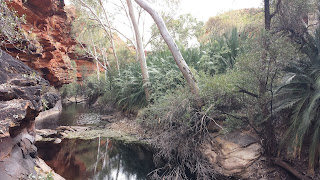The central Australian desert is an extreme arid
environment. For 20 million years, the
continent has been drying, its rivers turning to playas, its ground water
salting up, its inland plains and plateaus slowly disappearing under waves of
sand. The plant kingdom has not
abandoned the continent, though, and thousands of drought-tolerant plants
inhabit the red centre of Australia. This aridity is a fickle thing, however. In this wide brown land we call home, a
slight increase in water availability, or a bit of shade from the noonday sun
can make a big difference to a tropical, moisture loving plant.
A stunning example of this is the cycad.
As this
global distribution map shows, cycads
are mostly found in tropical to sub-tropical forests, and in Australia, they
hug the wetter coastal areas.
But there
is one species not shown on this map.
In the central Australian Macdonnell ranges, Macrozamia
macdonnelli is found in ravines, at the base of south facing cliffs, and in rare
desert oases, where ground water and sun protection allow it to cling to life as
the continent dried out. 1500 km from
the ocean and about as far from its nearest living relative, these cycads are
found through the MacDonnell and Hartz ranges of the Northern Territory, where steep ravines
channel water and shade the plants which grow within. Like an outlawed bushranger on the
run from the law, this plant and its pollinator sidekick have been hiding out
from the sun in the secret mountain waterholes for millions of years.
